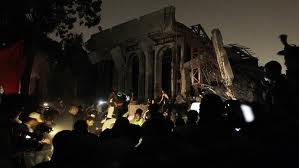NATO’s military intervention in Libya began as an enforcement of a no-fly zone to protect civilians but has quickly morphed into an attack on civilian targets to undermine the morale of Gaddafi loyalists in order to turn them against the country’s leader.
NATO has struck Gaddafi’s residence repeatedly, and in recent days attacked a TV broadcast center.
If it sounds like a rerun of NATO’s 1999 air war on Yugoslavia, when NATO showered bombs on civilian targets in order to “protect” civilians, that’s because NATO has dusted off an old script.
The campaign over Libya, according to senior US officers, draws on lessons from 1999. (1)
Here was US General Michael Short 12 years ago on the logic of the NATO bombing campaign.
If you wake up in the morning and you have no power to your house and no gas to your stove and the bridge you take to work is down and will be lying in the Danube for the next 20 years, I think you begin to ask, “Hey, Slobo, what’s this all about? How much more of this do we have to withstand?” (2)
Short told The New York Times that the bombing campaign was based on “hopes that the distress of the Yugoslav public will undermine support for the authorities in Belgrade.” (3)
Here’s US General John P. Jumper today, who was commander in 1999 of US Air Force units in Europe.
It was when we went in and began to disturb important and symbolic sites in Belgrade, and began to bring to a halt the middle-class life in Belgrade, that Milosevic’s own people began to turn on him. (4)
Jumper says NATO is following the same logic in Libya today.
How NATO got away with bombing civilian targets in Belgrade in 1999 offers insight into how it’s getting away with bombing civilian targets in Tripoli in 2011.
First, then as now, no one was big enough and strong enough to stop them.
Second, NATO bamboozled enough people into believing Serb forces were slaughtering ethnic Albanians in Kosovo to win support for an intervention as the only way to avert a bloodbath (sound familiar)? The tens of thousands of corpses NATO ministers warned would be found scattered across Kosovo and buried in the Trepca mines, were never found.
Third, NATO simply made the definition of a military target so malleable that it could fit just about any site NATO planners wished to destroy. Roads and railways were said to be legitimate quarry, because they were used by military vehicles. Bridges allowed military units to move easily from one point to another, and therefore could be taken down as legitimate military targets. Radio-television buildings were fair game because they were deemed to be part of the enemy’s “propaganda apparatus” (which means, if we’re to apply a consistent standard, that The New York Times’ building is a legitimate target for any country the United States attacks.) Government buildings were part of the enemy’s command and control infrastructure, and as a consequence could be obliterated as lawful targets. And the schools, hospitals and people destroyed by NATO bombs that couldn’t be passed off as legitimate military targets were dumped into the convenient category of “collateral damage.”
Peter Ackerman, the moneybags who hobnobs with Zbigniew Brzezinski and Robert Gates on the US foreign policy elite’s Council on Foreign Relations, and who founded an organization to promote color revolutions, created a documentary about the downfall of Milosevic, called Bringing Down a Dictator. It credits so-called nonviolent pro-democracy activists—not NATO’s bombing of civilian targets to turn Milosevic’s supporters against him–with bringing about Milosevic’s ouster.
Maybe Ackerman’s definition of non-violence (and of dictator: Milosevic was elected in multiparty elections which continued to be carried out after he became president) is as malleable as NATO’s definition of a military target.
What’s clear is that NATO and the color revolution outfit Ackerman founded have the same goal: to sweep leaders of non-satellite countries from power in order to integrate their countries unconditionally into the global economy as Western vassal states.
If the goal can be achieved by bombing civilians to weaken their morale, NATO is up for it, as much today as it was in 1999.
Notes
1. Thom Shanker and David E. Sanger, “Nato says it is stepping up attacks on Libya targets”, The New York Times, April 26, 2011.
2. Washington Post, May 24, 1999.
3. New York Times, May 13, 1999. Cited in William Blum’s Rogue State: A Guide to the World’s Only Superpower.
4. Shanker and Sanger.


Sorry, the comment form is closed at this time.